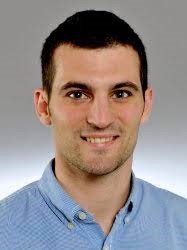News

INTERVIEW with 2021 G. COLONNETTI MEDALLIST, EMILIO MARTÍNEZ-PAÑEDA
Dr Emilio Martínez-Pañeda is a Senior Lecturer and 1851 Research Fellow at Imperial College London, UK. Dr Martínez-Pañeda’s research efforts aim at understanding, predicting and optimising the mechanical response of materials. Current interests include the embrittlement of metals in aggressive environments, dislocation-based continuum plasticity, micromechanics of rock fracture, multi-physics modelling, and the development of computational methods for predicting fracture and fatigue. Dr Martínez-Pañeda is one of the two 2021 Gustavo Colonnetti medallists. His presentation at the 75th RILEM Annual week was titled “Predicting the lifetime of infrastructure susceptible to hydrogen embrittlement and corrosion damage”.
********************************************************************************************************************************************************************************************************************************************************************
RIM: Congratulations again, Emilio, for your RILEM award! I understand that this 2021 RILEM Colonnetti medal is just one of an endless list of prizes and awards that I read in your CV.
E. Martínez-Pañeda: Thank you! I have indeed been lucky in being nominated and awarded other prizes by colleagues. It is always nice as they mean recognition for your work. I am particularly happy about the award of the Gustavo Colonnetti medal as I have high regard for RILEM. Being recognised by colleagues at RILEM is very important for me.
RIM: When did you join RILEM?
E. Martínez-Pañeda: I joined more than 4 years ago although I have not been a member continuously. My dynamic academic career is to blame here, as I have moved across institutions, some of which were institutional members while others not. I started my relationship with RILEM back in 2017 when I was invited to join the RILEM TC 293-CCH Stress Corrosion Cracking and Hydrogen Embrittlement of Concrete-Reinforcing Steels, chaired by Dr Javier Sanchez Montero. At that time, I was working at the Technical University of Denmark (DTU), an institutional corporate member. I then moved to the University of Cambridge and I assumed that I was still a member through my institution, but it seems that it wasn’t the case. I am now finally settled at Imperial College London and back again to the RILEM membership, so I look forward to continuing to engage with RILEM and convincing my colleagues to make Imperial College an institutional RILEM member.
RIM: … and what a place to be stable!
E. Martínez-Pañeda: Yes! I think about it every morning. Imperial College is a great place to work. With many RILEM members and outstanding scientists and engineers. Actually, I remember that my colleague Dr Hong Wong was hosting a RILEM TC meeting at Imperial only a few days after I started the job. He kindly gave me the chance to engage with the participants and it was a great experience.
RIM: So… you are not new to RILEM. How did this medal happen? Did you know about the previous calls? Did anyone encourage you to apply?
E. Martínez-Pañeda: I was very kindly encouraged by Dr Javier Sanchez and Dr Alvaro Ridruejo. I took a look at the previous awardees and thought that they had lost their mind. I came back to them saying that I wasn’t anywhere near that list of distinguished scientists. But they insisted and the rest is history - they are most often right I should say!
RIM: What are you going to do with your RILEM membership? Have you looked at the current TCs? Thinking to join any of them?
E. Martínez-Pañeda: I have always been involved with RILEM, since the beginning of my academic career, and I plan to continue to do so. I will definitively continue my activities within TC 293-CCH as this Technical Committee is very close to my research work. Problems like hydrogen embrittlement and stress corrosion are gaining increasing attention so I think that it is important that they are present in RILEM through one or several TCs. I will be happy to actively support those efforts.
RIM: I was wondering if you could tell us more about your research and its impact in the society.
E. Martínez-Pañeda: If we think of the realm of RILEM, materials and structures, some will argue that, while some challenges remain, we have reached a good understanding of how materials and structures behave “on their own”, in an inert environment. However, the moment material-environment interactions come into play, then the problem becomes much trickier and interdisciplinary. You need to link materials science, mechanics, chemistry… Environmental effects are behind most structural failures. We have learned a lot through experiments about important phenomena like corrosion, corrosion-fatigue, stress corrosion cracking, hydrogen embrittlement… but these problems have long been considered too complex to predict mechanistically. We use empirical considerations to prevent environmentally assisted failures but I am convinced that we have reached a point where we can finally use computers to deliver more reliable, mechanistic predictions. My research group has been very actively working on this: in developing a better understanding material-environment interactions through experiments and theory, and on developing large-scale computational models that can deliver predictions relevant to engineering practice. For examples, some of the models that we have developed for fracture mechanics, hydrogen embrittlement or corrosion fatigue are used nowadays by industry.
RIM: Are these models “engineer-friendly” or only people with a PhD can understand how to use this software?
E. Martínez-Pañeda: We engage with industrial partners in a variety of different ways. Some want us to run the calculations ourselves to tackle a specific issue that they have. Others want to incorporate our modelling capabilities into their portfolio. For those, we provide our models and, if needed, also training and/or documentation so that their engineers can readily use them.
RIM: This is fantastic! Are your models included in commercial packages too?
E. Martínez-Pañeda: Yes, we have implemented some of our models in commercial finite element packages like Abaqus or COMSOL. I do my best to make sure that my research has an impact on industry and society. Simulation-based assessment (Virtual Testing) can have a profound impact on competitiveness. They used to crash hundreds of cars to design a new car model; now they mostly crash cars in computers. And by doing this, they saved billions of course…
RIM: … not to mention the environmental impact!
E. Martínez-Pañeda: Exactly! And one could argue that this success has not been seen in the construction industry. At least in the context of environmental failures. There are some good reasons for this: one is the bigger scale and the other is the complexity of material-environment interactions – our structures are exposed to rain, seawater, etc… that is where the challenges lay. No one is going to use Virtual Testing if they do not trust the model! And this is what we are trying to do, to provide models that engineers can trust to design the next generation of bridges, wind turbines. This is our ultimate goal!
RIM: It is a very admirable project! It is also nice to see the willingness to share the details of the model and the code.
E. Martínez-Pañeda: I have always been very committed to open science. On my website one can download for free all my codes. This enhances scientific progress and allows others to reproduce my results. I think (hope!) that this is being very useful for the academic community. In general, it doesn’t make sense that academics spend time developing what fellow colleagues have developed already. It is also a very rewarding experience to receive the feedback of people that found my codes useful.
RIM: We will not see you in Merida in person…
E. Martínez-Pañeda: Unfortunately not. I was really looking forward to going to Merida but with Mexico on the UK’s red list it has not been possible.
RIM: I have one last question for you Emilio: is there anything that you particularly enjoy as a RILEM member?
E. Martínez-Pañeda: There are many things about RILEM that I like, of course. But the one that I like most is the people. The community of people that RILEM puts together encompasses leading professionals from both academia and industry, with common interests. You get the chance to meet remarkable people. And this is also very important for our work of course. For example, European projects typically require building consortia across academia and industry. By joining RILEM one can easily build such a network.
RIM: Emilio, thank you again for your time. It has been a real pleasure!
E. Martínez-Pañeda: Thank YOU for this opportunity and for this nice interview.














No comment
Log in to post comment. Log in.